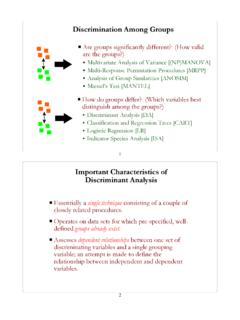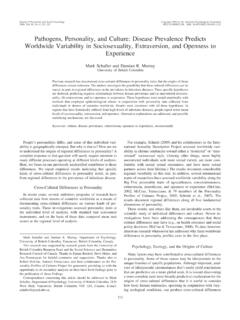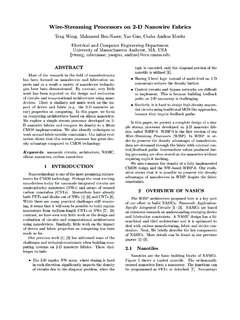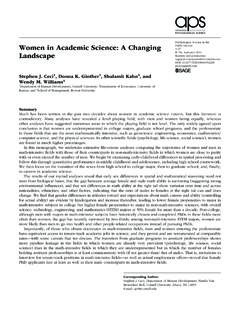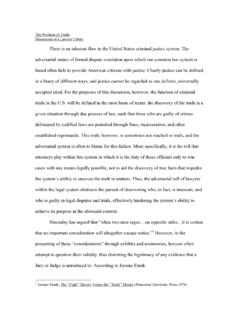Transcription of DEPARTMENT OF ECONOMICS - umass.edu
1 DEPARTMENT OF ECONOMICS . Working Paper Information and communications technologies, coordination and control, and the distribution of income by Frederick Guy and Peter Skott Working Paper 2007-11. UNIVERSITY OF MASSACHUSETTS. AMHERST. Information and communications technologies, coordination and control, and the distribution of income Frederick Guy Peter Skotty 17th July 2007. Abstract We consider the links between information and communications technologies (ICTs). and the distribution of income, as mediated by problems of coordination and control within organizations. In the large corporations of the mid-twentieth century, a highly developed division of labor was coordinated and controlled with the aid of relatively underdeveloped ICTs. This created a situation in which the options of top manage- ment were constrained while the individual and collective power of lower paid workers was enhanced.
2 Only in the late twentieth century, when the microprocessor and re- lated technologies transformed the information systems of organizations, did improve- ments in the tools of coordination and control race ahead of the growing demands of coordination and control. These technological changes have reduced the power of lower-paid employees, increased that for higher-paid employees, and led to an increase in income inequality. Thus, the more important aspects of new technology relate to the power-bias', rather than the skill-bias', of technological change. JEL numbers: J31, O33. Key words: communications technology, power-biased technical change, inequality, work intensity, e ciency wage. School of Management and Organizational Psychology, Birkbeck College, Malet St, London WC1E. 7HX, UK; y DEPARTMENT of ECONOMICS , University of Massachusetts, Amherst, MA 01003, USA;. 1 introduction From 1940 to 2000, income inequality in the United States traces a sort of lop-sided U, falling abruptly in the 1940s and then rising, slowly in the mid 1950s and 1960s, more rapidly from the late 1970s onwards (Lindert, 2000; Kopczuk, Saez and Song, 2007).
3 What the high-income households lost in the 1940s was largely property income, while what they gained from the late 1970s onwards has been wage and, to a lesser extent, entrepreneurial income (Piketty and Saez, 2007). Evidence from a variety of sources suggests that a similar "great compression" took place in other industrial capitalist economies in the 1940s, as did the replacement of property with wage and entrepreneurial income (see, , Moriguchi and Saez, 2007; Piketty et al., 2006). However, in many countries, the compression of the income distribution has not been reversed, or was reversed later and less dramatically than in the US. Many explanations have been o ered for parts of this great U turn, and a few ex- planations have attempted to encompass all of it. Among economists, the hegemonic explanation for increased income inequality from the 1970s onwards was, until recently, skill-biased technological change (SBTC).
4 Even by generous readings, however, SBTC. cannot account for the extreme rises in wage income for the top one percent, nor can it account for the abruptness of the compression in the rst place. A second class of explanations attributes the compression, and de-compression, to in- stitutional changes. Many of these - changes in tax rates, social insurance, minimum wage legislation, the legal framework of industrial relations, and the organizational reach of trade unions - came just before or just after the second world war. Wartime mobilization itself has often been seen as a spur to egalitarianism, both in attitudes and in institutions. And, clearly, the US and other countries in which income inequality rose so quickly from the late 1970s onwards saw, in that period, sharp reversals of some of the equalizing in- stitutional changes of the great compression itself: the Reagan and Thatcher revolutions, and similar waves of liberalization in the other Anglophone countries.
5 The large contribu- tion of institutional changes to the fall and rise of inequality is undeniable, and yet these changes raise at least as many questions as they answer. War may, as a rule, be a social leveler, but the leveling is not always cemented with durable institutional changes. Even in the US, where the great compression was relatively short-lived, inequality continued falling for nearly a decade after the war, and pre-war levels of inequality were not reached again until the 1980s. Why did the leveling institutions last as long as they did, and why did a great wave of liberalization, and rising inequality, sweep the English-speaking indus- trial economies around 1980? And why did the 1940s also see a reduction in inequality in neutral countries, such as Spain (Alvaredo and Saez, 2006), and Sweden (Roine and Waldenstrom, 2006)? Our argument in this paper is that changes in information and communications tech- nologies (ICTs) used in workplaces contributed to the fall and rise in American inequality.
6 These same technologies tend to be the focus of the SBTC literature, but contrary to the 1. SBTC hypothesis, we argue that the path from technology to distribution runs through technology's e ects on agency costs, rather than skills. We accord a central role to institu- tions, but we see the institutional changes in question as partly endogenous. Our analysis owes a great deal to two distinct strands of literature. One of these is a literature on the changing organization of production, both within and between rms, with an emphasis on the information systems required for coordination and control (Chandler, 1977; Beniger, 1984; Yates, 1989). The other is the literature of agency - the formal study of the costs of controlling individual and collective employee behavior when contracts are incomplete (Alchian and Demsetz, 1972; Bowles, 1985; Gintis and Ishikawa, 1987).1. We argue that the compression of incomes in the 1940s was in part a response to problems created by the expansion of managerial business in the preceding decades.
7 The leveling of incomes was a result of the limitations of the available information and com- munications technologies for coordination and control of these new, large enterprises. In ways that we detail below, the burdens of coordinating large, complex, and geographically dispersed companies enhanced the bargaining power of those lower in the hierarchy, and reduced that of top managers. From the 1970s onwards, advances in ICT improved co- ordination and control, reducing the agency rents accruing to those lower in the corporate hierarchies. The exibility that the new ICTs brought also created new rents for those at the top of the hierarchies. Following our terminology in Skott and Guy (2007a), we refer to changes in the relative ability of di erent groups to extract rents as a result of changes in workplace technology as power biased technological change (PBTC). The rest of this paper is organized as follows.
8 Section 2 lays out the relationship between information systems and agency in the operation of large organizations. Section 3. presents the argument for power-biased technological change in the mid-twentieth century, and for the inversion of this power bias in the late twentieth century. Section 4 discusses the implications of the technological changes for the power of managers. Section 5 uses a small model to analyze the e ects of PBTC in a more formal setting. Section 6 brie y considers the relation between skill and power, and the relationship between the intra- rm issues addressed elsewhere in this paper and institutional change is broached in Section 7. Section 8 o ers a few concluding comments. 2 Communications technology and problems of coordina- tion and control economic growth is associated with an increasing division of labor, for the familiar reasons given by Adam Smith (1776), and any division of labor creates a need to coordinate the various specialized workers involved.
9 For this reason, Machlup (1962) tells us, economic 1. In its emphasis on institutions and relative power, our analysis has a nities with a number of other contributions, incl. Freeman (1996), Gordon (1996), Howell and Wieler (1998), Levy and Temin (2007). 2. growth comes with a growing share of work being devoted to information tasks - the overhead costs, if you will, of the division of labor. Moreover, as the division of labor grows, the economy's information requirements change qualitatively as well as quantitatively: we do not simply have more mercantile accounts in the manner of 15th century Venice, but di erent kinds of accounts - cost accounting, capital accounting, and complex nancial instruments. In the late nineteenth century, as a result of growing markets and new production technologies, there were gains to be had from creating large companies. Within a large company, some subset of the increasingly elaborate division of labor was carried out in a deliberately coordinated way - Chandler's (1977) visible hand.
10 There are important di erences between visible and invisible hand coordination, but both hands rely on the reduction of the unstructured knowledge held by many di erent people to common and communicable forms that we call information. Hayek's (1945). information-theoretic reading of markets is instructive here: he maintains that the mar- ket's e ciency advantage over the central plan lies in its ability to distill vast amounts of local knowledge (what Polanyi (1962) calls tacit knowledge) into a single price vector. Yet, similar, if less extreme, reductions in the dimensionality of information take place within planned systems, including rms: the creation of standard categories and meas- ures, whether for products, people, or processes, necessarily omits or distorts some features that might be salient, but this is a cost of establishing communication between o ces in an organization, and in so doing facilitating coordination and control.



